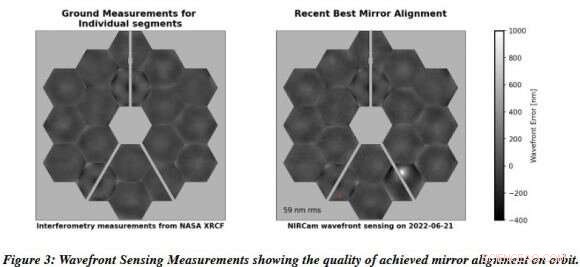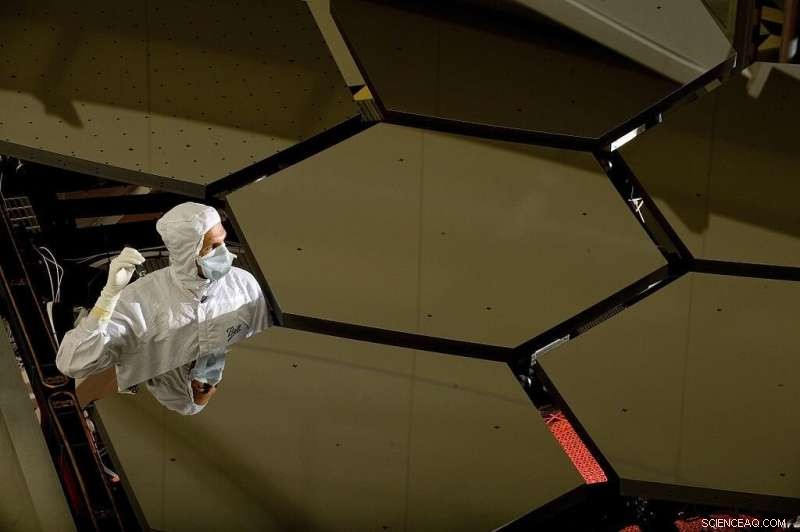
Comparación de las alineaciones del espejo de Webb, tomadas del informe "Caracterización del rendimiento científico de JWST desde la puesta en servicio" (12 de julio de 2022). Crédito:NASA/ESA/CSA
El mundo todavía se está recuperando del lanzamiento de las primeras imágenes del Telescopio Espacial James Webb (JWST). Estos proporcionaron una descripción general completa del tipo de operaciones científicas que Webb llevará a cabo durante su misión de 20 años. Incluyeron la mirada más sensible y detallada de algunos objetos astronómicos icónicos, espectros de la atmósfera de un exoplaneta y una vista de campo profundo de algunas de las galaxias más distantes del universo. Desde su lanzamiento, también hemos podido ver destellos de objetos en el sistema solar capturados por los instrumentos infrarrojos de Webb.
Mientras tanto, la colaboración de JWST publicó un informe completo titulado "Caracterización del desempeño científico de JWST desde la puesta en marcha", en el que examinaron todo lo que Webb ha logrado hasta ahora y lo que anticipan a lo largo de la misión. Este documento apareció recientemente en línea y cubre todo, desde la navegación del telescopio y la orientación hasta el rendimiento de sus muchos instrumentos. Un dato interesante, que no se publicó anteriormente, es cómo Webb sufrió una serie de impactos de micrometeoritos, uno de los cuales provocó un "cambio incorregible" en un segmento del espejo.
El equipo detrás de este estudio incluyó investigadores de las tres agencias espaciales participantes:la NASA, la Agencia Espacial Europea (ESA) y la Agencia Espacial Canadiense (CSA), y de las muchas agencias asociadas de la misión. Estos incluyen el Instituto de Ciencias del Telescopio Espacial (STScI), el Instituto Niels Bohr, el Max-Planck-Institut für Astronomie (MPIA), el Centro de Tecnología de Astronomía del Reino Unido (UK ATC), el Consejo Nacional de Investigación de Canadá (NRCC), el Instituto Nacional de Técnica Aeroespacial (INTA), el Centro de Astrobiología (CAB) y muchas empresas aeroespaciales, universidades, institutos de investigación y agencias de todo el mundo.
El documento que compilaron evalúa el desempeño del JWST durante el período de puesta en marcha de seis meses antes de que entrara en servicio el 12 de julio de 2022. Este consistió en caracterizar el desempeño en órbita del observatorio, el diseño y la arquitectura del JWST, y el desempeño previsto antes del lanzamiento. Estos se compararon luego con el rendimiento de la nave espacial, los telescopios, los instrumentos científicos y el sistema terrestre. La Sección 4 del Informe, Rendimiento óptico, aborda cómo funcionaron los diversos instrumentos de Webb durante el período de puesta en servicio.

Un segmento de espejo primario del telescopio espacial James Webb, hecho de berilio. Crédito:NASA/MSFC/David Higginbotham/Emmett Dado
El espejo principal del JWST consta de dieciocho segmentos hexagonales dispuestos en una configuración de panal. Cada segmento está compuesto de berilio chapado en oro y todos están alineados para garantizar la mayor resolución y sensibilidad posibles. El rendimiento general se mide en términos de error de frente de onda (WFE), que se refiere a cómo la luz captada por los espejos del telescopio se desvía de la longitud de onda de luz esperada. La extensión general se determina calculando la desviación de la luz recolectada del error de raíz cuadrada media (RMS), el promedio esférico de todo el frente de onda.
Esto se expresa matemáticamente usando las unidades de la longitud de onda particular, medida en nanómetros (nm) cuando se trata de longitudes de onda infrarrojas. La Sección 4.7 aborda los impactos de micrometeoritos y su efecto potencial en el rendimiento óptico a largo plazo de Webb. La evaluación comienza recordando a los lectores que cualquier nave espacial inevitablemente se encontrará con micrometeoroides, luego enumera cómo se esperaban varios impactos durante el período de puesta en servicio:
"Durante la puesta en servicio, la detección del frente de onda registró seis deformaciones superficiales localizadas en el espejo primario que se atribuyen al impacto de los micrometeoroides. Estos ocurrieron a un ritmo (aproximadamente uno por mes) consistente con las expectativas previas al lanzamiento. Cada micrometeoroide causó una degradación en el frente de onda del impacted mirror segment, as measured during regular wavefront sensing. Some of the resulting wavefront degradation is correctable through regular wavefront control; some of it comprises high spatial frequency terms that cannot be corrected."
They further indicate that these micrometeoroid impacts were detected so far through wavefront sensing. Five of the six detected impacts had negligible effects, contributing to a combined total of less than 1 nanometer to the overall wavefront error. However, the remaining impact, which occurred between May 22nd and May 24th, caused a "significant uncorrectable change" in the overall figure of segment C3. This segment is located on the lower right side of Webb's primary mirror (when seen from the front), and the effect is illustrated in the Report (see image above).
Luckily, the overall effect was small since only a small portion of the telescope area was affected by it. The mission teams also conducted two realignment steps to correct for the impact, which brought the telescope alignment to a minimum of 59 nm RMS, which is about 5 to 10 nm above the previous best wavefront error RMS values. The authors of the Report also go on to note that "drifts and stability levels" in the telescope typically result in a "telescope contribution" of between 60 (minimum) to 80 nm RMS—at which point, wavefront control is typically performed.
They also explain that it is unknown at this time whether or not the May 2022 impact to segment C3 was rare or something that can be expected to happen frequently throughout JWST's mission. As they state, this is essential if the JWST mission teams hope to determine if the telescope will be more susceptible to damage by micrometeoroids than pre-launch modeling predicted:
"The project team is conducting additional investigations into the micrometeoroid population, how impacts affect beryllium mirrors, and the efficacy and efficiency tradeoffs of potential mitigations such as pointing restrictions that would minimize time spent looking in the direction of orbital motion, which statistically has higher micrometeoroid rates and energies."
To summarize, the impact on the C3 segment raised concerns among the mission controllers. But the upside is that it was nothing they couldn't address and is not expected to affect Webb's long-term science operations. As the Report summarizes:
"The key outcome of six months of commissioning is this:JWST is fully capable of achieving the discoveries for which it was built. JWST was envisioned 'to enable fundamental breakthroughs in our understanding of the formation and evolution of galaxies, stars, and planetary systems'… we now know with certainty that it will. The telescope and instrument suite have demonstrated the sensitivity, stability, image quality, and spectral range that are necessary to transform our understanding of the cosmos through observations spanning from near-earth asteroids to the most distant galaxies."
Moreover, the Report's authors conclude that the JWST's performance has been better than expected, almost across the entire board. In terms of the optical alignment of its mirrors, the point spread function, the time-stability of its imaging, and the fine guidance system that points the observatory, Webb has exceeded expectations. They also indicate that the mirrors are cleaner, and the science instruments have generally provided higher total system throughput than pre-launch expectations. All of this adds up to some optimistic appraisals:
"Collectively, these factors translate into substantially better sensitivity for most instrument modes than was assumed in the exposure time calculator for Cycle 1 observation planning, in many cases by tens of percent. In most cases, JWST will go deeper faster than expected. In addition, JWST has enough propellant on board to last at least 20 years."
The JWST Collaboration stated that further details will be presented in a planned series of papers. These will appear in a special issue of the Publications of the Astronomical Society of the Pacific (PASP) dedicated to the JWST. James Webb telescope hit by micrometeoroid:NASA